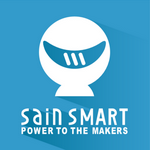SainSmart PEBA Filament Profile
SainSmart PEBA Filament: Print Next-Gen Flexible Parts
Welcome to the ultimate resource for getting started with SainSmart PEBA (Polyether Block Amide) filament! Often hailed as the "Super TPU," PEBA is an advanced flexible material that combines the strength of nylon with the elasticity of an elastomer. It delivers unmatched performance where energy return, lightness, and speed are critical.
Use the resources below to bypass the typical learning curve associated with new flexible filaments and start creating high-performance, functional parts.
What Makes PEBA the Next-Gen Flexible Filament?
SainSmart PEBA is engineered for applications where traditional TPU falls short. Its unique molecular structure provides a distinct set of advantages:
- Ultra-High Rebound: With up to 78% energy return, PEBA prints parts that act like functional springs, perfect for cushioning, athletic gear, and robotics.
- Lightweight: It is up to 20% lighter than standard TPU, making it ideal for drones, wearables, and performance components where mass is a critical factor.
- Faster Printing: Optimized for high flow, PEBA allows for significantly faster print speeds than comparable flexible materials, increasing your productivity.
- Durability: Excellent resistance to cyclic fatigue, low temperatures, and various chemicals, ensuring your prints last longer in demanding environments.
1. Bambu Studio Printer Configuration File
To ensure successful, high-speed printing right out of the box on Bambu Lab printers, use our specially tuned filament profile. This file contains the optimized settings for temperatures, retraction, and speed.
Resource Type | Description | Download Link |
Bambu Filament Profile | Basic print profile for SainSmart 90A PEBA filament in Bambu Studio (.bbsflmt file). |
Installation Instructions:
- Download the
.bbsflmtfile using the link above. - Open Bambu Studio.
- Go to File > Import > Import Configs.
- Select the downloaded
.bbsflmtfile. - The new filament preset will now be available for selection under your installed filaments.
2. Sample 3D Models (.STL) for PEBA
These sample models are perfect for testing the unique flexibility, rebound, and lightweight characteristics of your SainSmart PEBA filament. They represent common use cases for this advanced material.
Model Name | Description | Recommended Usage Notes | Download Links |
Tennis Ball | A hollow, lattice-structure model to test high rebound and compression/snap-back. | Excellent for testing the Energy Return characteristic. | |
Pillow | A flexible, functional cushion model to test adjustable softness and low compression set. | Demonstrates Cushioning and Shock Absorption. | |
Insole | A model of a customizable shoe insole. | Ideal for showcasing Comfort and Wearable applications. | |
Basketball | A printed basketball model. | Best results are achieved using a 0.6mm nozzle for strength and reduced print time. |
3. Quick Printing Tips for PEBA Success
For the best results with any high-performance flexible material, we recommend following these general tips:
- Drying is Critical: Like all polyamides, PEBA is highly hygroscopic. Always dry your filament (recommended 6-8 hours at 70°C) before printing and store it in a dry box or sealed container with desiccant during use.
- Use a Direct Drive Extruder: Flexible materials perform best on direct drive systems, as they minimize the distance the soft filament must be pushed.
- Watch the Retraction: If you experience stringing, keep retraction distance short (1-2mm) and retraction speed low (25-35 mm/s) to prevent tangling or clogging.
- Bed Adhesion: A thin layer of glue stick on a textured or smooth PEI sheet can provide excellent adhesion for the first layer. Recommended bed temperature is typically around 40-60°C.

